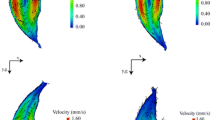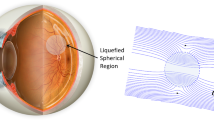Numerical calculations of the aqueous humor dynamics in the anterior chamber of a rabbit's eye are presented to delineate the basic flow mechanisms. The calculations are based on a geometrical model of the eye, which represents the Trabecular meshwork (TM) as a multilayered porous zone of specified pore sizes and void fraction. The outer surface of the cornea is assumed to be at a fixed temperature (corresponding to the ambient temperature), while the iris surface is assumed to be at the core body temperature. Results are obtained for both the horizontal upward-facing orientation of the eye, and the vertical orientation of the eye. Parameters varied include: the temperature difference between the iris and the cornea to underscore the important role of buoyancy in driving the aqueous humor flow; and, the pupil size reflecting different levels of ambient light. Buoyancy is observed to be the dominant driving mechanism for the convective motion in both orientations of the eye. Variations in the pupil size appear to have little influence on the IOP or flow distribution in view of the dominant role of buoyancy in controlling the flow motion. The study provides distributions of the shear stress and flow patterns and delineates the important role of the eye-orientation on these results.










Similar content being viewed by others
REFERENCES
Canning, C. R., J. N. Dewynne, A. D. Fitt, and M. J. Greaney. Fluid flow in the anterior chamber of a human eye. IMA J. Math. Appl. Med. Biol. 19:31–60, 2002.
Doormal, J. P., and G. D. Raithby. Enhancements of the SIMPLE method for predicting incompressible fluid flow. Numer. Heat Transf. 7:147–163, 1984.
Epstein, D. L., T. F. Freddo, P. J. Anderson, M. M. Patterson, and S. B. Chu. Experimental obstruction to aqueous outflow by pigment particles in living monkeys. Invest. Opthalmol. Vis. Sci. 27:387–395, 1986.
Ergun, S. Fluid flow through packed columns. Chem. Eng. Prog. 48(2):89–94, 1952.
Ethier, C. R., M. F. Coloma, A. W. Kater, and R. R. Allingham, Retroperfusion studies of the aqueous outflow system. Invest. Opthalmol. Vis. Sci. 34:(2):385–394, 1992.
Ethier, C. R., R. D. Kamm, M. Johnson, A. F. Pavoo, and P. J. Anderson, Further studies on the flow of aqueous humor through microporous filters. Invest. Opthalmol. Vis. Sci. 30:739–746, 1989.
Ethier, C. R., R. D. Kamm, B. A. Palaszewski, M. C. Johnson, and T. M. Richardson. Calculations of flow resistance in the juxtacanalicular meshwork. Invest. Opthalmol. Vis. Sci. 27:1741–1750, 1986.
Gerlach, J. C., G. Hentschel, K. Zeilinger, M. D. Smith, and P. Neuhas. Cell detachment during sinusoidal reperfusion after liver preservation, in vitro model. Transplantation 64:907–912, 1997.
Grant, W. M., Experimental aqueous perfusion in enucleated human eyes. Arch. Ophthalmol. 69(6):783–801, 1963.
Heys, J. J., and V. H. Barocas. Computaional evaluation of the role of accommodation in pigmentary glaucoma. Invest. Opthalmol. Vis. Sci. 43:700–708, 2002.
Heys, J. J., and V. H. Barocas. A boussinesq model of natural convection in the human eye and the formation of Krukenberg's spindle. Ann. Biomed. Eng. 30:392–401, 2002.
Heys, J. J., V. H. Barocas, and M. J. Taravella. Modeling passive mechanical interaction between aqueous humor and iris. J. Biomech. Eng. 123:540–546, 2001.
Huillier, J. P., and G. A. Sbirlea, T. B. Martonen. Morphology of the human eye: Glaucoma physiology and laser iridectomy. In: Medical Applications of Computer Modelling: Cardiovascular and Ocular Systems, edited by WIT, United Kingdom, pp. 225–242, 2000.
Johnson, M. C., and R. D. Kamm. The role of Schlemm's canal in aqueous outflow from the human eye. Invest. Opthalmol. Vis. Sci. 24:320–325, 1983.
Johnson, M. C., R. D. Kamm, W. M. Grant, D. L. Epstein, and D. Gasterland. The flow of aqueous humor through micro-porous filters. Invest. Opthalmol. Vis. Sci. 27:92–97, 1986.
M. Johnson, A. Shaprio, C. R. Ethier, and R. D. Kamm. Modulation of outflow resistance by the pores of the inner wall endothelium. Invest. Opthalmol. Vis. Sci. 33:1670–1675, 1992.
Kocak, I., S. Orgul, and J. Flammer. Variability in the measurement of corneal temperature using a non-contact infrared thermometer. Ophthalmologica 213(6):345–349, 1999.
Lindenmayer, J. M., M. G. Kahn, E. Hertzman, and D. L. Epstein. Morphology and function of the aqueous outflow system in monkey eyes perfused with sulfhydryl agents. Invest. Opthalmol. Vis. Sci. 24:710, 1983.
Lehto, I., P. Ruusuvaara, and K. Setala. Corneal endothelim in pigmentary glaucoma and pigment dispersion syndrome. Ophthalmologica 68:703–709, 1990.
Mallinson, G. D., and G. D. V. Davis. Three-dimensional natural convection in a box: A numerical study. J. Fluid Mech. 83(1):1–31, 1977.
McEwen, W., Application of Poiseuilles's law to aqueous outflow. Arch. Ophthalmol. 60(2):290–294, 1958.
Mclaren, J. W., S. D. Trocme, S. Relf, and R. F. Brubaker. Rate of flow of aqueous humor determined from measurements of aqueous flare. Invest. Opthalmol. Vis. Sci. 31(2):339–346, 1990.
Mori, A., Y. Oguchi, Y. Okusawa, M. Ono, H. Fyhusguna, and K. Tsubota. Fujishima, and use of high-speed, high-resolution thermography to evaluate the tear film layer. Am. J. Ophthalmol. 124:729–735, 1997.
Mullenax, C. A., “Doctoral Research Prospectus,” available at (http://www.studentweb.Tulane.edu/~cmullen/documents.html), pp. 6.
Okuno, T. Thermal effect of infra-red radiation on the eye: A study based on a model. Ann. Ocuup. Hyg. 35:1–12, 1991.
Palkama, A., and R. Beureman. Ocular fluid dynamics measured with vivo confocal microscopy and microbeads. Ophthalmology, 2001.
Scott, J. A. The computation of temperature rises in the human eye induced by infrared radiation. Phys. Med. Biol. 33:243–257, 1988.
Scott, J. A., A finite element model of heat transport in the human eye. Phys. Med. Biol. 33:227–241, 1988.
Tripathi, R. C., and B. J. Tripathi. Anatomy of the Human Eye, Orbit, and Adnexa. In: The Eye, Vol. 1a, Vegetative Physiology and Biochemistry, edited by Hugh Davson. New York: Academic, pp. 1–268, 1984.
Yedder, R. B., and E. Bilgen. Laminar natural convection in inclined enclosures bounded by a solid wall. Heat Mass Transf. 32:455–462, 1997.
ACKNOWLEDGMENTS
This work was supported by a grant from the Louisiana Board of Regents under a Health Excellence Support Fund program. Their support is gratefully acknowledged.
Author information
Authors and Affiliations
Rights and permissions
About this article
Cite this article
Kumar, S., Acharya, S., Beuerman, R. et al. Numerical Solution of Ocular Fluid Dynamics in a Rabbit Eye: Parametric Effects. Ann Biomed Eng 34, 530–544 (2006). https://doi.org/10.1007/s10439-005-9048-6
Received:
Accepted:
Published:
Issue Date:
DOI: https://doi.org/10.1007/s10439-005-9048-6




